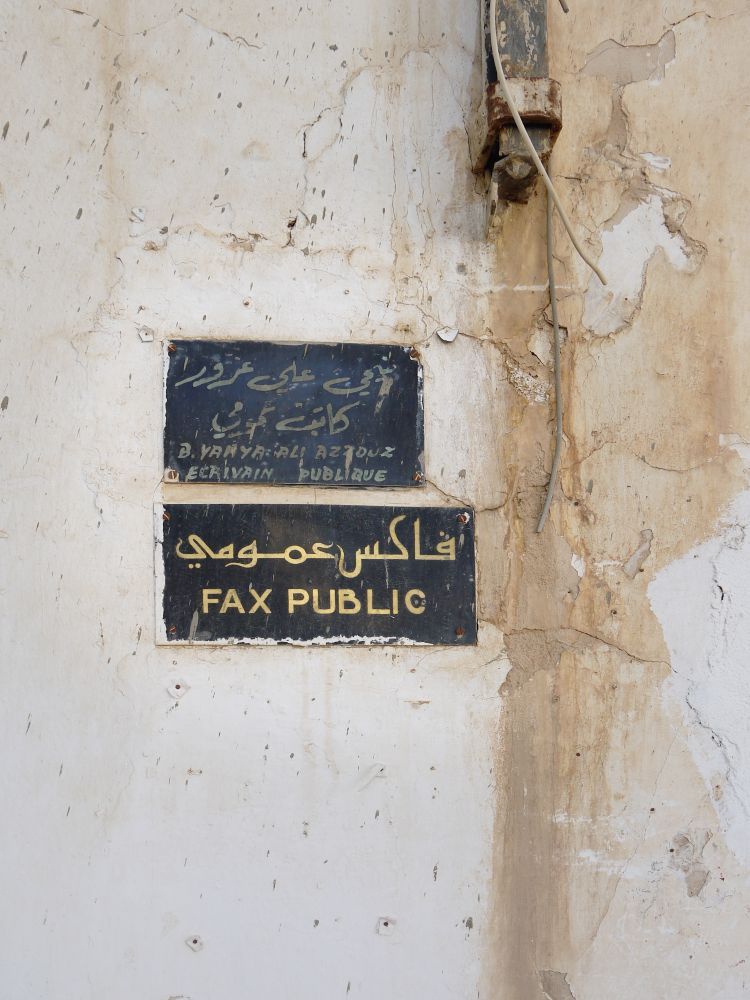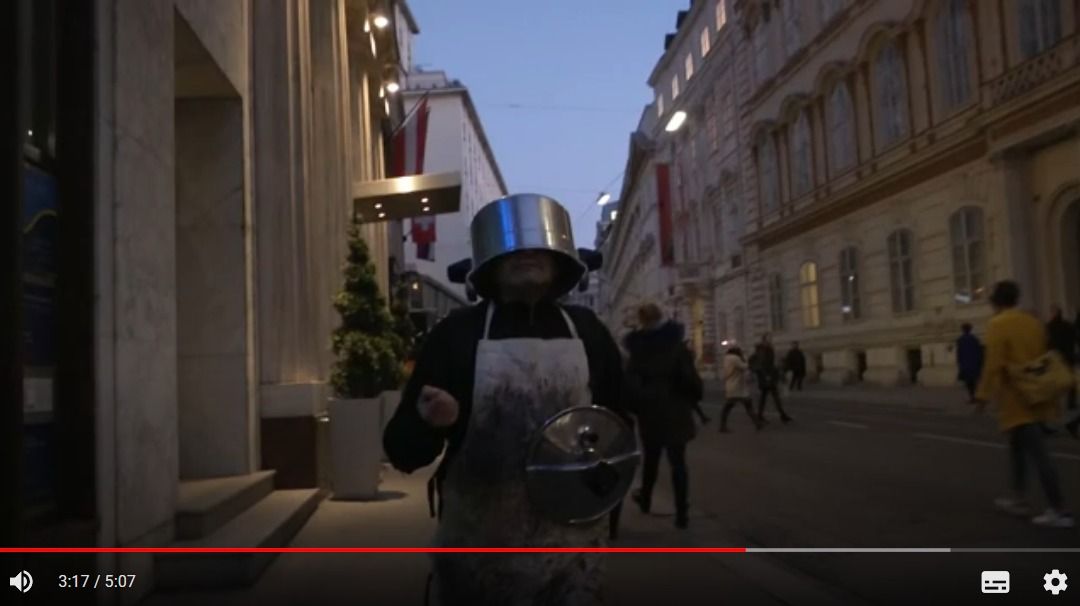THE TURN المنعرج - Art Practices In Post-Spring Societies
BackArtists
- With
Information
The changes and new beginnings brought about by the Arab revolution that started five years ago in Tunisia have made an impact far beyond the Arab world. Not only have people rebelled out of anger at their old regime and out of a burning desire for political and social change; this democratic movement has also effected a paradigm change in local art practices, and artists have begun to claim public space and to act as agents of civil society.
The exhibition THE TURN المنعرج presents several interventions that took place in public spaces in urban and rural post-revolutionary Tunisia. As expressions of socio-political issues and direct social engagement, they are rooted in the tradition of the “Social Turn” (Claire Bishop) in contemporary art history. This exhibition includes not only relicts of performances and installations, but also objects (some of which have been adapted to the white cube) and was designed by the curators with the following issues in mind: What remains of these projects, which international artists also took part in and which were largely funded by foreign institutions? Can we measure their effectiveness? What forms of archiving, collecting, and visualizing can be used for this often ephemeral and immaterial process-based art? What role does art play in times of transformations?
At the conference THE TURN المنعرج on March 18 in the Kunstraum Niederoesterreich, these questions will be discussed in-depth by artists, theorists, and representatives of funding institutions from Austria, Tunisia, Egypt, Libya, and Syria.
Contributors
- Kuration
Contributions
Anja Pietsch, Miriam Stock
BLASTI – C’est ma place, Tunis, 2013

BLASTI
Blasti – C’est ma place , Tunis, 2013
The photography project Blasti (‘my place’) began in October 2013, around the time when the topic of women’s position in society, especially, ignited heated debates in the Constituent Assembly of post-revolutionary Tunisia. Tunisian women, regardless of age or origin, were asked to photograph their favourite places and upload these images onto the map of Tunisia on www.blasti.tn.
Parallel to this interactive online project, the Blasti team invited women of different backgrounds to join a photography workshop. The participants made excursions through the city, from the traditional medina to the more exclusive suburb of La Marsa on the seaside, and translated their own ideas of ‘my place in Tunis’ into photographs. Afterwards these works were exhibited in the National Library of Tunis.
Representing diverse perspectives on public space in Tunis and Tunisia, these photographs are the result of both the virtual and real-world encounters of women who communicated and inspired each other and stand together for their place in newly-formed Tunisia.
Arslane Bestaoui
BYE BYE BAKCHICH SYSTEME Arrêt à la Corruption, Sousse , 2014
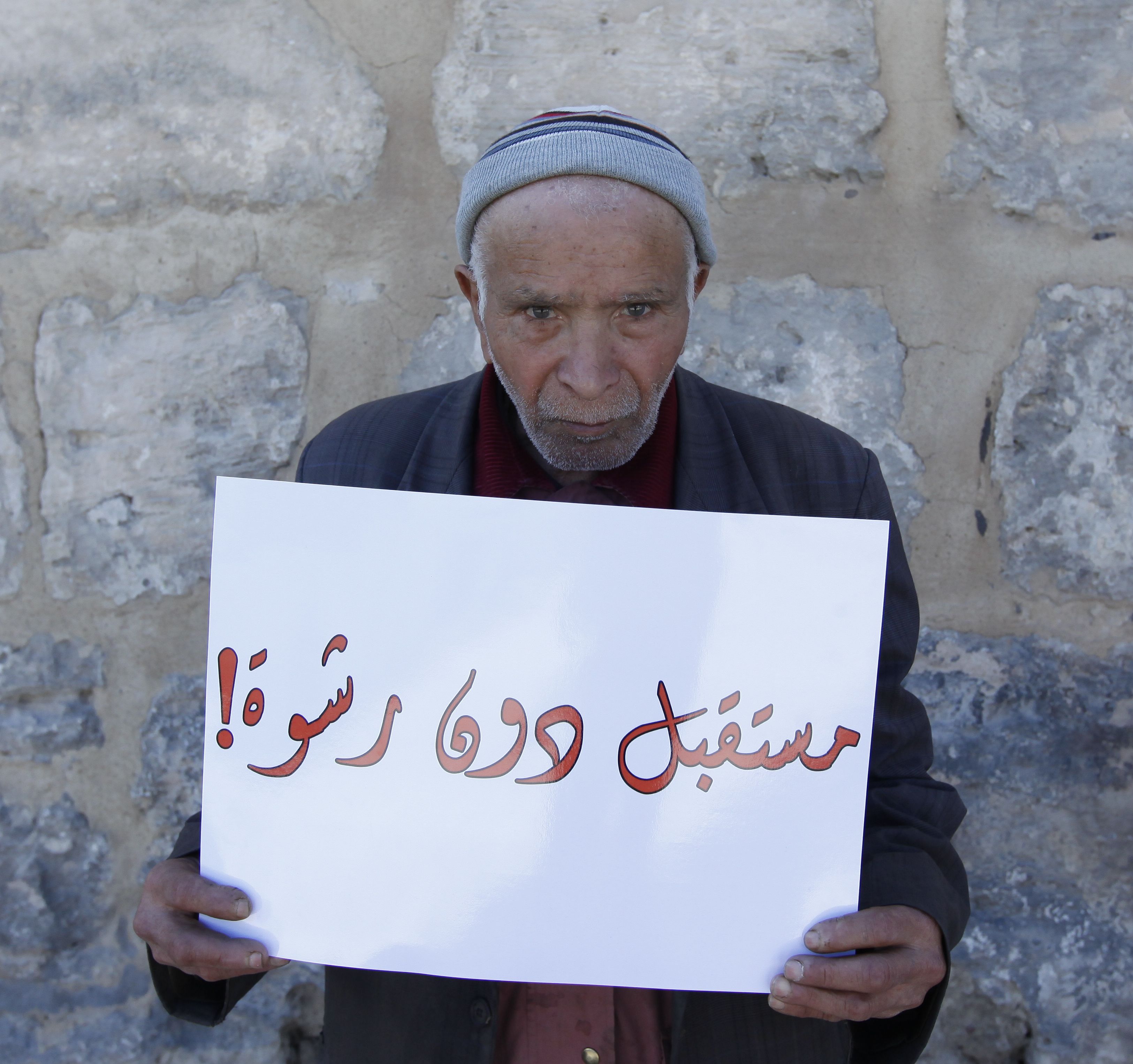
BYE BYE BAKCHICH SYSTEME
Arrêt à la Corruption, Sousse , 2014
At the beginning of the project, I had no clear idea for my artistic contribution. Then I did my own investigation by visiting the town of Sousse and talking with locals. After reflection and observation, I noticed that the people living in socio-economically disadvantaged neighbourhoods are the ones most affected by corruption. Thus I thought about building my installation where there are a lot of informal traders. I built a fake bus stop that I titled Arrêt à la Corruption (Bus Stop Corruption). The goal was for the people affected by this system to come forward and express their outrage. My Arrêt à la Corruption sign arose curiosity. I invited people over and explained my approach, in order to start a debate. At the end of the discussion, I gave them a sign to hold containing the slogan ‘Future without Corruption’. Afterwards, they all received their portrait, taken by an instant camera, as a testimony of their participation in the project. I wanted to raise awareness among the highest number of people.
Corruption has become a part of our daily habits, a large number of people take advantage of this system that infects all of society, and it’s the most disadvantaged ones who ultimately pay the price.
Let’s be aware of this phenomenon. Let’s STOP CORRUPTION and build a FUTURE WITHOUT CORRUPTION.
transparadiso
BYE BYE BAKCHICH SYSTEME Du Bakchich pour Lampedusa, Sousse, 2014

BYE BYE BAKCHICH SYSTEME
Du Bakchich pour Lampedusa , Sousse, 2014
Du Bakchich pour Lampedusa expands the issue of corruption in Tunisia to the European context and addresses the relationship between corruption and the withdrawal of income for social services of the state, which results in continual social inequality. This causes – together with a restrictive immigration policy – the complex problematic of refugees, who risk their lives to enter Europe for a supposed better future. For the installation, a garbage container was transformed into an oversized savings box as sculpture and placed right in front of the Great Mosque in the Medina of Sousse, surrounded by screens granting an intimacy similar to the settings of an election polling booth. The residents of Sousse were asked to donate 10% of their irregular income of the last 3 years to the savings box. In an official closing ceremony, the donations were handed over to the humanitarian aid organization African Intelligence (founded and directed by Father Jonathan, Sfax, which looks after rejected refugees from Lampedusa and provides education programs for them.
Christine Bruckbauer, Patricia K.Triki
CHRONOLOGIE unterschiedliche Handlungsorte, 2011–2016

CHRONOLOGIE
Chronologie ,, various venues, 2011–2016
The Chronologie creates awareness of the crucial situation of artists in Tunisia, informs about on-going harassment within the country aimed at artists from all disciplines, and proves cases of the government’s disregard of human rights.The Chronologie started in March 2011 and is continuously up-dated. It reports on actual incidents where cultural operators are deprived of artistic freedom. There have been repeated arrests and detentions by the police. The artists have also experienced rejection by conservative groups in the population who attacked them verbally and physically. An accumulation of negative incidents loomed especially during the term of the first democratically elected government headed by the Islamist party Ennahda (English: Renaissance). The Chronologie is a matter-of-fact presentation, using the exact wording of official press releases and displayed using timelines installed on walls in highly frequented streets and places in Tunis. The installation has to be done under cover of night.
Noutayel Belkadhi
DE COLLINE EN COLLINE La Cellule de Lumière, Sidi Bou Saïd, 2013

DE COLLINE EN COLLINE
La Cellule de Lumière , Sidi Bou Saïd, 2013
The artwork consists of a moving sculpture powered by an electric motor.
Noutayel Belkadhi wanted to bring joy and peace into a world of striving and restlessness. La Cellule de Lumière, built for the village Sidi Bou Saïd, evokes the designation of the place on the horn of Carthage. Its mystic spirit, already appreciated by religious hermits and sufis in the last centuries, seems to have almost vanished in the modern era due to touristic and consumerist interests.
Placed in a lush front garden beside a popular tourist route, Belkadhi’s sculpture invites observers to rest and immerse themselves in contemplation. The turning light tube does not describe a perfect circle; rather it appears to be organic and alive. Following the erratic movements of a flexible light hose, the spectator gets carried away, stimulating meditation and soul searching.
Johanna Kandl, Helmut Kandl
DE COLLINE EN COLLINE L’oasis – La couleur verte, Chènini, 2013
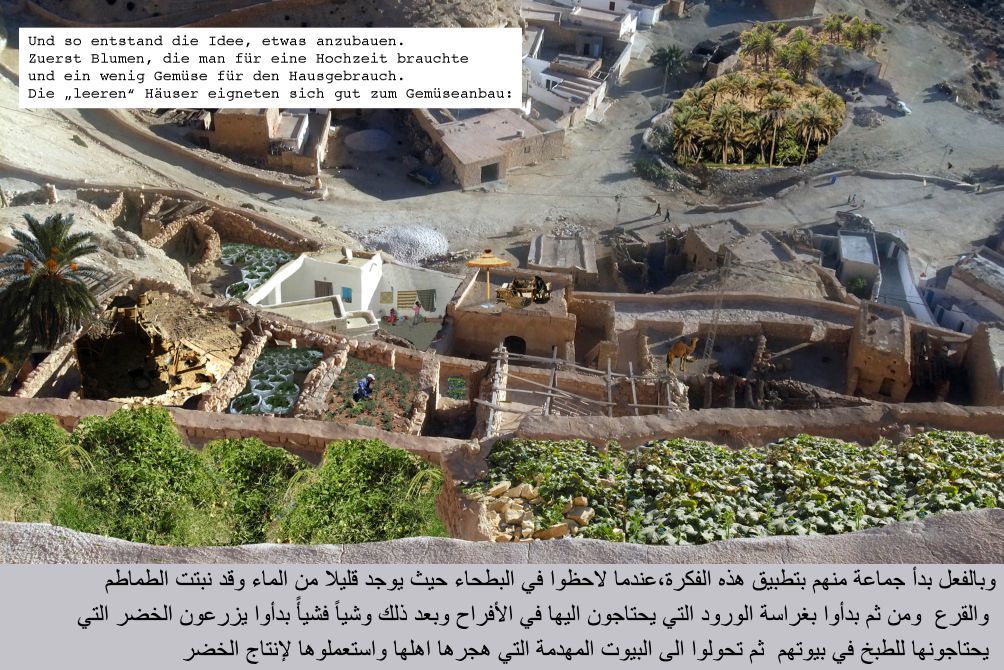
DE COLLINE EN COLLINE
L’oasis – La couleur verte , Chènini, 2013
A report from the year 2020:
How did this rapid transformation of the Maghreb countries come about? How can one explain that suddenly, like out of nowhere, many things began to improve?
How did it happen that the region has largely disappeared from the political news headlines and now is mostly mentioned in connection with fashion shows, Oscar Awards, book fairs, and holiday trips?
Interestingly enough, the changes didn’t begin there where one would suppose – in the big cities, headed by the intellectual elite – but in the small villages…
That is how our video made in 2013 for Chenini begins, a fictional retrospect from the year 2020, in which we outline – suggestively and a bit naïve – how a positive development could run its course. […)
Huda Lutfi
DE COLLINE EN COLLINE Cactus Walk, Sidi Bou Saïd, 2013
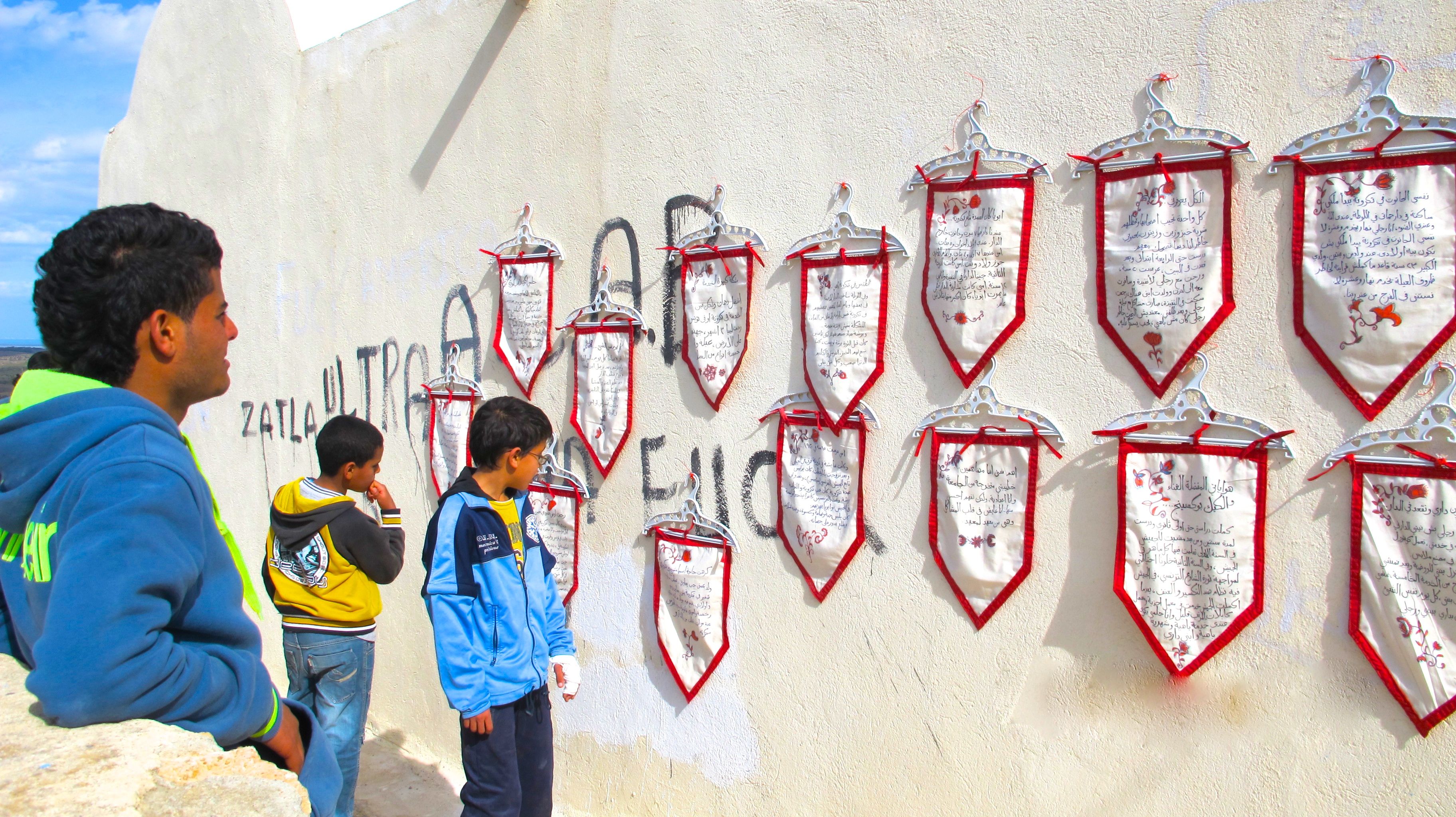
DE COLLINE EN COLLINE
Cactus Walk , Sidi Bou Saïd, 2013
An installation on a windowless wall, not far from a shrine… There the artist installed giant wooden crutches, with a collage of cacti pictures on them. The artist wanted to show the present impediments (‘hashuna saqeena’). During the performance, the crutches were at the disposal of locals for imaginative use.
Stories from Takrouna , Takrouna, 2013
The installation shows fragments of stories that are the outcome of the artist’s interviews and conversations with women and men from the hillside village of Takrouna. They talked about their lives, wishes, and dreams. Huda Lutfi wrote fragments of their narratives on pieces of cloth attached to hangers. Afterwards, the artist framed and decorated the pieces and suspended them like medals of honors on a wall on top of the hill.
Faten Rouissi
DE COLLINE EN COLLINE Chenini, 2013
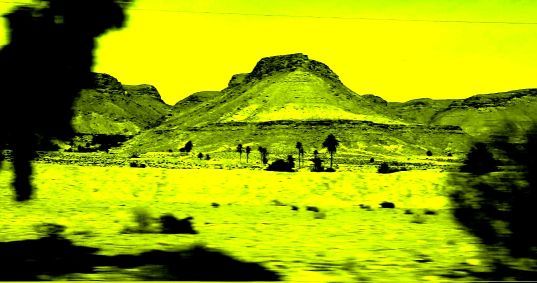
DE COLLINE EN COLLINE
De Colline en Colline , Chenini, 2013
In Southern Tunisia, there is an attractive road leading from the town of Tatouine to the hill of Chenini. The environment is weighty, rich and robust. Through my video we can perceive bushes and people hastily moving about at the forefront, while the landscape in the background, so imposing with its steep hills, resists this fast pace, conveying a reassuring stability.
Inkman
DJERBAHOOD Calligraffiti, Erridah, Djerba, 2014
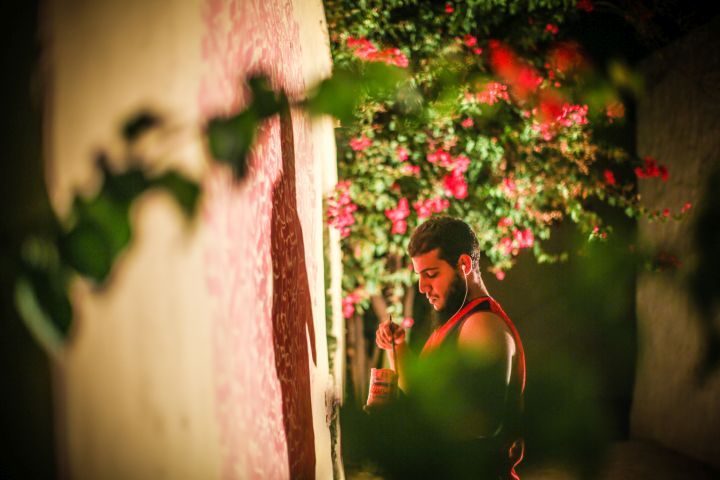
DJERBAHOOD
Calligraffiti , Erridah, Djerba, 2014
‘In the first place, when I came to Erriadh I didn’t have a specific idea of what I was going to do! But after a walk through the village’s quiet corners I sensed some inspiration. I start by closing my eyes, to speak the language of my heart – speaking thoughts and feelings, knowing that every piece I create will become a living dream, a smile of a newborn baby. It’s all about the beauty of calligraffiti, inspired by the soul of the village, the noise, colours, and architecture.’
‘It was the most amazing adventure I have ever had. My relationships with Erriadh’s inhabitants were very intense. Old men talked to me, gave me their advice or encouragements, and commented strongly on my work. This and the smiles and energy of the children gave me power and stimulus – everyone in the village wanted to help! Apart from that, the other participating artists were also very special. We had interactive discussions, good experiences, and especially good vibes.’
(Notes from the artist’s diary during ‘Djerbahood’ in summer 2014)
Omar Abusaada
DREAM CITY While I am Flying Away, Tunis, 2015

DREAM CITY
While I am Flying Away , Tunis, 2015
The pupils of Nahj Al Wazeer Elementary School guided the audience of Dream City 2015 through an intimate journey inside their school, where every child accompanied an audience member into his/her own world. The intimate world of each child was located at a specific corner inside the school.
The borders of this world were created by the children's amazing narration skills and creative imagination and went far beyond the school walls.
Each child's journey took audiences to marginalised neighbourhoods in the old town of Tunis where they got to know the people who live there and their life conditions.
The journeys did not stop there. The children flew with the audience into rich worlds where the real is mixed with the imaginary, and memories mixed with dreams and desires.
These journeys remind adults of the beauty of children’s imagination and vocabulary, both of which make our life less cruel and violent.
Mohamed Allam
DREAM CITY Yao Ming – Tunis, Tunis, 2012
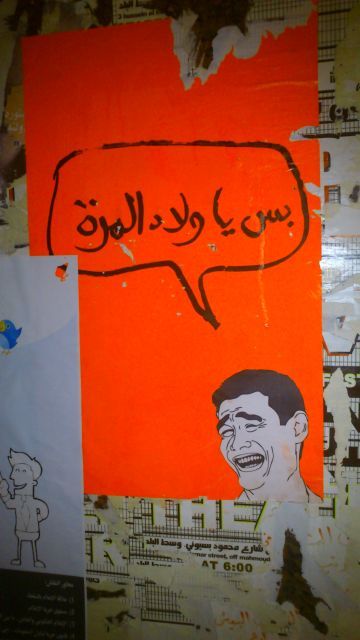
DREAM CITY
Yao Ming – Tunis , Tunis, 2012
What if the famous meme of Yao Ming invaded the streets as a substitute for the virtual world? How would the population react to this invader, this grotesque caricature normally spread using social networks?
The citizens of Tunis have witnessed the answer to this question. Mohamed Allam’s artwork for Dream City 2012 was an interactive installation through which Yao Ming became jovially embedded in private and public properties, in political propaganda as well as advertising material, meaning to awaken passers-by acquainted with internet culture. Some people used the posters as free space to communicate strong messages.
Irena Eden, Stijn Lernout
ECRIVAIN PUBLIC Tunisia, 2014
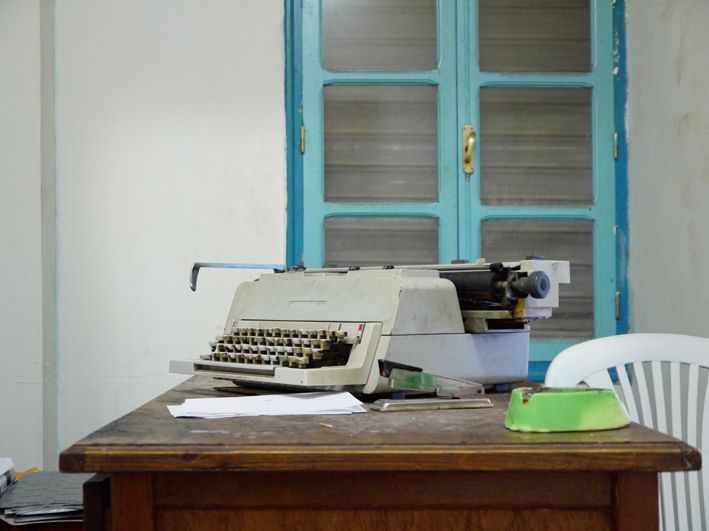
ECRIVAIN PUBLIC
Écrivain public , Tunisia, 2014
In Tunisia, the profession of the public scrivener is still very much alive. When you drive in the countryside, through the towns and villages, time and again you will notice signs on the streets indicating an Écrivain public. People use this offered service in different ways, but the focus is typically on correspondence with public authorities.
In 2014, Irena Eden and Stijn Lernout went on a trip through the country. They followed local signs and visited twenty-four public scriveners. They entered the work places as customers and asked the scriveners for a text. Their main question was: How are current events – subjectively seen – in the scrivener’s respective locality described? Which stories, which reports are relevant and find their way into a text?
Selma & Sofiane Ouissi
LAAROUSSA Une poétique du geste – Laaroussa, verschiedene Standorte, 2011
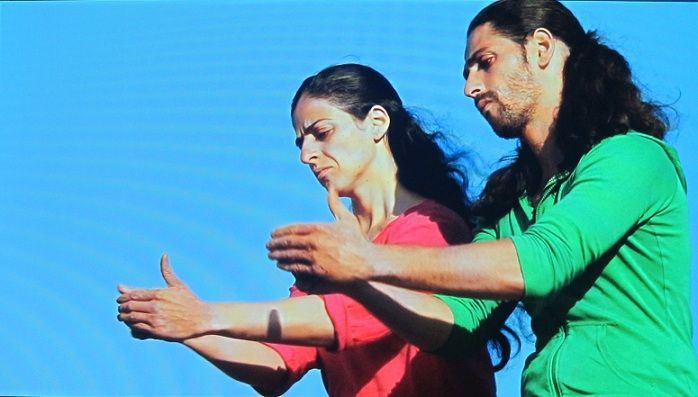
LAAROUSSA
Une poétique du geste – Laaroussa , various venues, 2011
The clay-work of Sejnane takes shape according to certain ancestral gestures transmitted from one generation to another. The craftswomen extract clay from earth, crush bricks, mould and model. In their hands, raw material becomes dolls, spoons, plates. Impregnated with these movements skilfully mastered and willingly reiterated, Selma & Sofiane Ouissi, the duo of choreographers, have collected their material throughout the workshops to create an unreleased choreography, blankly staging the potters’ gestures. The choreographers thus set a choreographic writing process like a sign alphabet which that explores the poetic extent of the movement between work and dance. Starting with gesture portraits, CeCil Thuillier, the filmmaker, Nicola Sburlati, the editor, and David Bouvard, the sound landscapes creator, produced a poetical film. This plural artwork, meant to be distributed indoors and out, was wholly conceived in situ. It is imagined as the metaphor of a secular and regional know-how, transcended by a contemporary artistic vision.
Halim Karabibene
MNAMC verschiedene Handlungsorte, 2007–2016
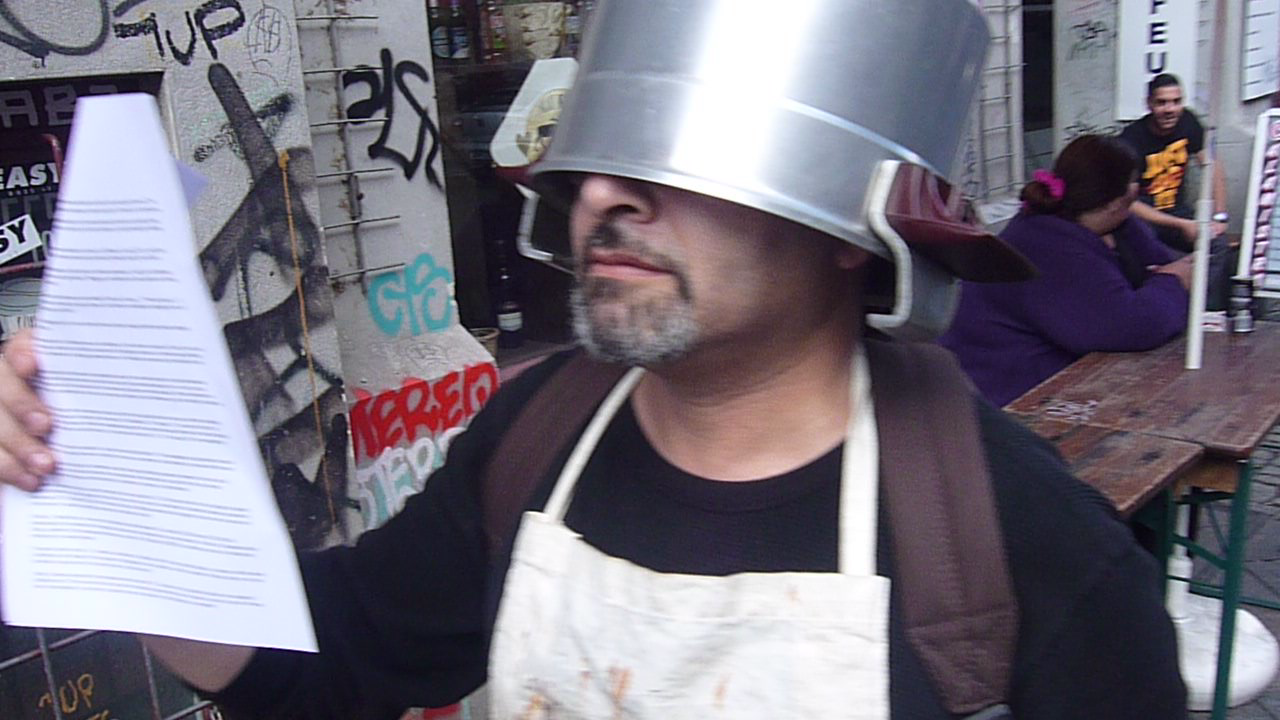
MNAMC , various venues, 2007–2016
The Tunis National Museum of Modern and Contemporary Art (MNAMC) is a museum that does not exist or that still does not exist! Since 2007, Halim Karabibene has been trying to make it real by creating false events in its name, in reality and on the Internet. The pressure cooker being the architectural form of the future museum (which would be inaugurated in 2069), is its symbol and logo. It’s also the symbol of Tunisia, a country in turmoil, on the verge of explosion.
It is a ‘work in progress’, a form of ironic awareness directed at the lack of a museum of modern and contemporary art in Tunisia.
In January 2011, after the ‘explosion’, Halim Karabibene left his studio and changed his medium in order to devote himself to participatory work and create performances, street actions, photos, videos, and a series of engravings with the cooker as an emblem.
The cooker thus became the MNAMC protection committee’s armour, a Don Quixote-like committee dedicated to protecting the dream of the museum, which has become more within reach thanks to hopes raised by the ‘revolution’.
Moufida Fedhila
SUPER–TUNISIAN […] unterschiedliche Handlungsorte, 2011–2016
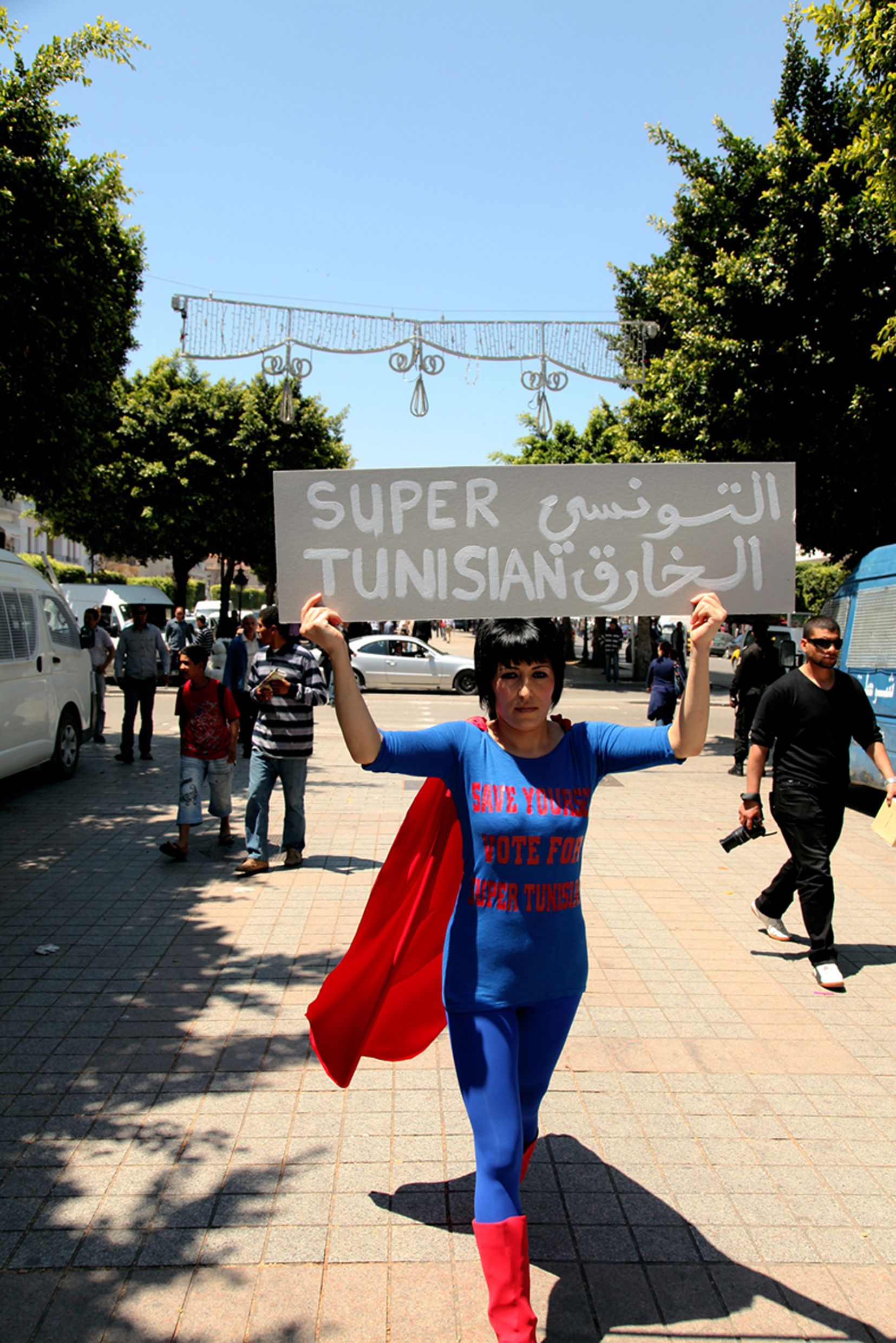
SUPER–TUNISIAN
Super-Tunisian […] , different venues, 2011–2016
At a time when the Arab Spring has shown the difficulty for citizens of Tunisia to shift from democratic aspirations to their application in political reality, the work of Moufida Fedhila resonates as a deep and knowledgeable reflection. Indeed, from the aftermath of these legitimate effervescence, the artist, refraining from any naiveté, showed vigilance and caution about the prospects of the announced social changes. As a female subject, Moufida Fedhila presents the exemplarity of a female citizen’s participation. Rather, for Fedhila, it is a natural commitment, exercised through healthy performative audacity to induce lucid and analytical thinking. In 2011, she played; live on Habib Bourguiba Avenue, a unifying place of popular uprisings in Tunis, in Super-Tunisian_Star't, an inaugural performance lacking neither irony nor especially constructive expectancy. Incredulous to demagogic speeches that were so common in that turbulent period, the artist preferred to sharpen her critical thinking, the only weapon for free minds, by mise-en-abyme the messianic expectation implied by the election of a president or a party that was allegedly providential, with her piece (Super-Tunisian_Hors Limites, 2014). She has also forced the line by deliberately offering the character of a president invested as Superman, not without wry humour, with the rank of ‘Super-Tunisians’ (Super-Tunisian_Extra Time and Super-Tunisian's in a fix, she's calling on chance, 2012). The artist focuses mainly on observing a slow change in beings - and their exchanges – just like alchemy evolving in a global athanor, where she perfectly identifies the levers and springs of our contemporary global societies.
(by Michèle Cohen-Hadria)
Images (16)











